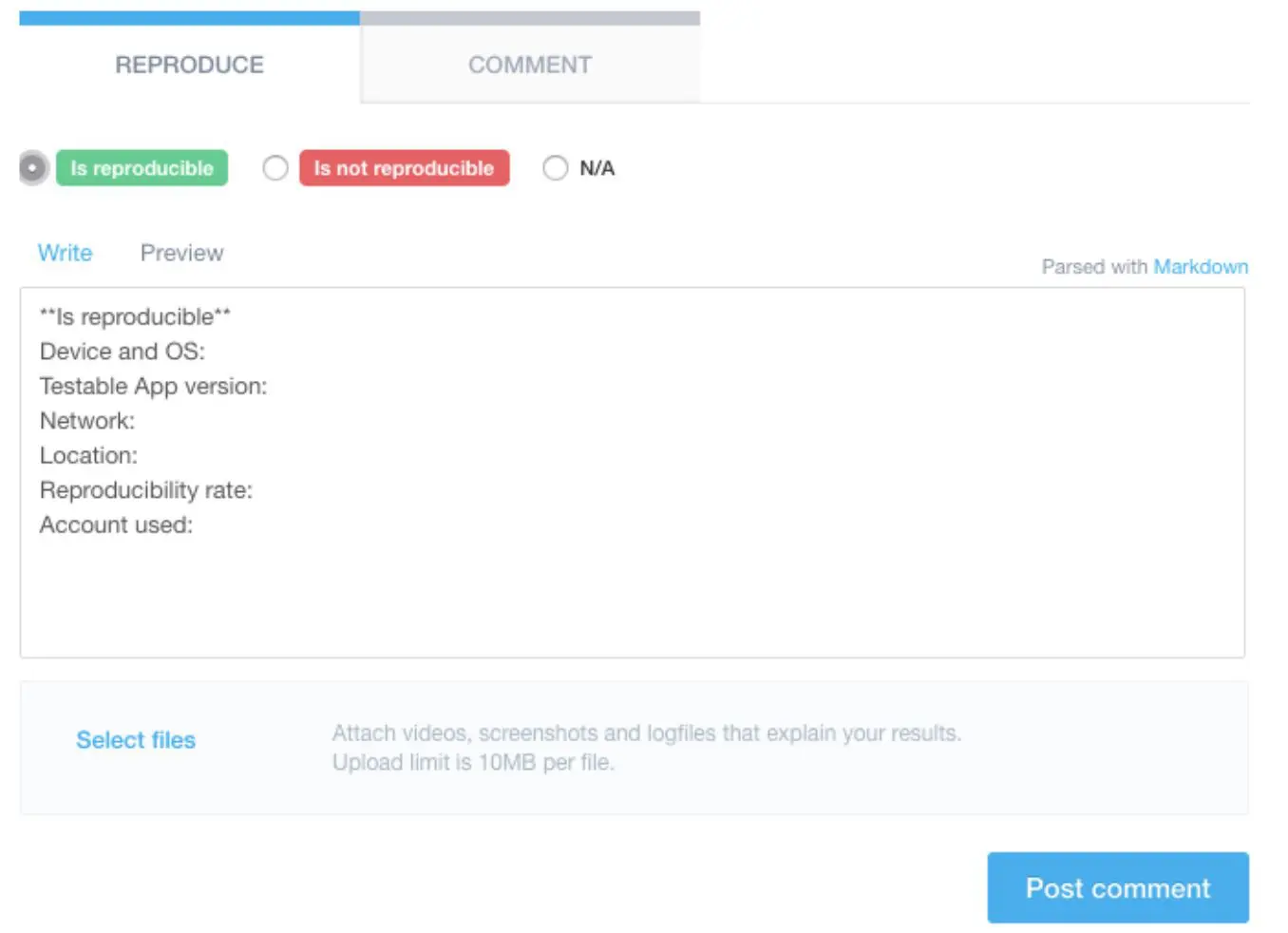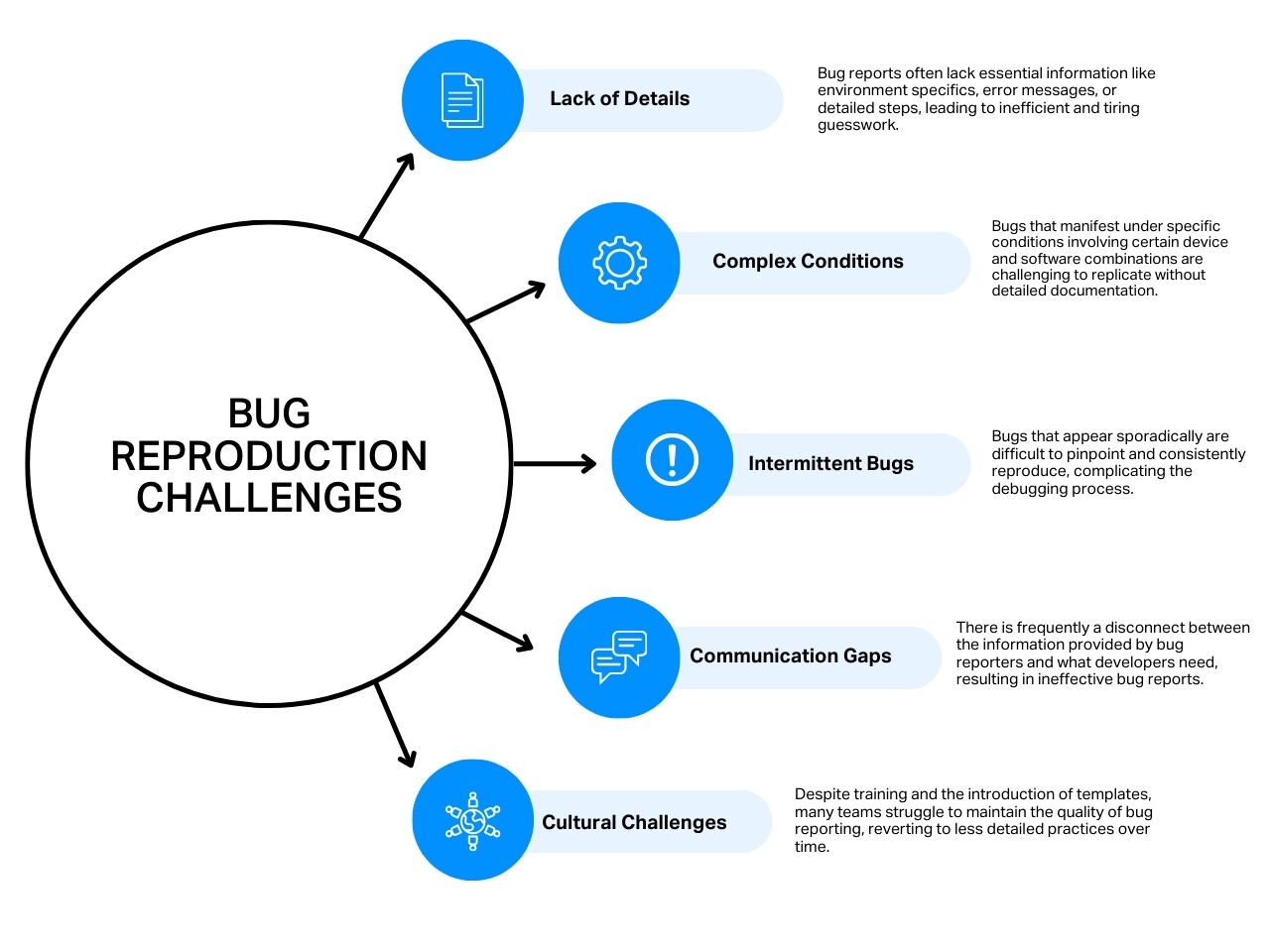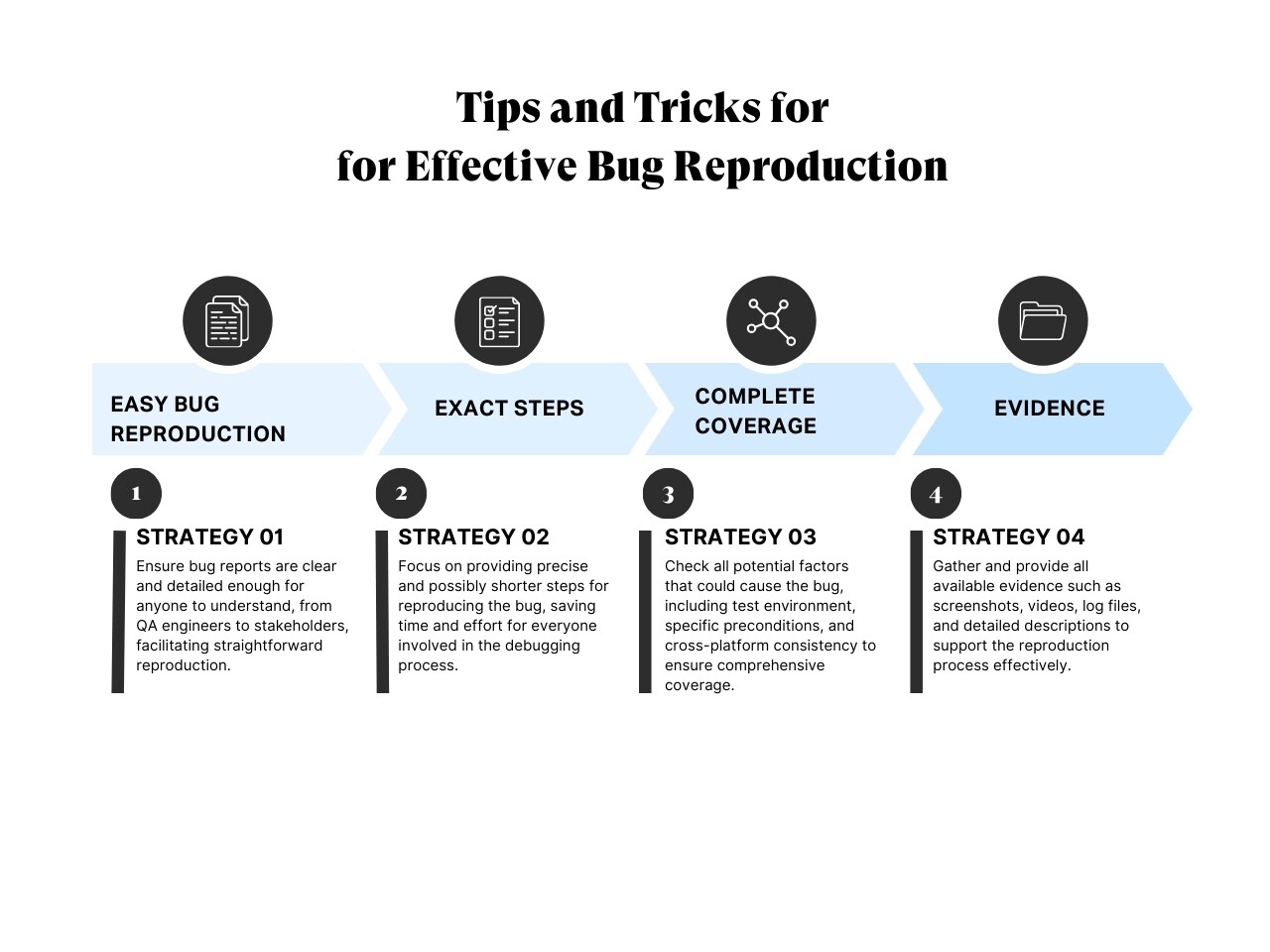Issue Reproduction: Why Reproducing Bugs Matter

Software bugs are a natural occurrence in the software development cycle but they sure can be the bane of app developers’ lives. To fix issues swiftly and efficiently, they must be reproducible in the development environment.
From a software testing standpoint, this means that finding a bug is just the tip of the iceberg – being able to show consistently and step-by-step the mechanisms leading to a particular issue allows testers to deliver actionable bug reports that make fixing problems easier for the developer team.
Simply put, once a problem has been found, it must be replicated, and the steps leading to it must be properly documented. If the root cause of the issue is unknown, it can’t be fixed. Hence why bug reproduction is a crucial step in the software testing life cycle and essential to delivering flawless web and mobile app experiences.
To explore this topic further, we asked our Community Test Lead, Bryan, to share his thoughts and best practices.
Related: Meet a Tester: Bryan

So, What Is Bug Reproduction?
Bug reproduction, also known as issue reproduction, is the process by which a software tester reproduces a defect in software. Recreating the same circumstance that caused the bug to occur and then analyze how it impacts the software.
Bug replication is one of the most important components of testing since it assists developers in identifying issues, determining how to repair them, and preventing similar issues from occurring in the future.
The more detailed information testers can offer about the steps they took to uncover a fault, the simpler it will be for developers to recreate it on their own.
Why Is Bug Reproduction Important?
Reproducing bugs offers a unique perspective into the methodologies of other testers. The ability to pinpoint and detail the specific steps leading to a bug is essential for any skilled tester. This process has not only improved my abilities but also opened my eyes to learning from the experiences of others, thereby enhancing my own testing skills.
However, to be honest, at the beginning of my testing career, I wasn’t very fond of bug-reproducing tasks. This was primarily because many issues were complex, and some bug reports were poorly documented, making them difficult to understand. However, as I developed my skills and gained experience over time, I began to see the value in these tasks.
I have found that taking on bug reproduction tasks opens my mind to new testing ideas and methodologies when I’m stuck in a rut. This is especially true when the project has been running for a long while, and I feel like I have exhausted all my test ideas or reported every possible issue.
Performing issue reproduction tasks can also be very enlightening for testers who are new to a specific project. Reproducing other testers’ issues helps them get a better feel for the app itself and for the project requirements (since most may have different rules on how to write bug reports).
At Testlio, issue reproduction tasks are performed across all projects in every test cycle. We want to be sure that the issues we send to the customer are easily understandable and actionable. Thus, it’s important to eliminate any unwanted feedback and noise—especially considering that when hunting an application for bugs, you can end up with various software problems (ranging from insignificant to major).
So, when reproducing bugs, we ensure that we are not reporting one-time anomalies that have almost zero chance of happening in real-life situations.
Not only does this help increase the quality of issues reported to the clients, but it also provides an important learning point for testers.
How Do You Tackle Bug Reproducing Tasks?
When I get assigned bug reproduction tasks, I first skim through all the issues assigned to me – and try to categorize them systematically. For example, if I get assigned 10 issues, of which 3 require the user to be logged out of the application, I will group these together and reproduce them simultaneously instead of logging in and out every so often. Categorizing issues helps to address them in a swift and organized manner.
In most test cycles, issue reproduction is performed before issue validation. This step confirms whether the reported bug is valid or not. Thus, approving and rejecting issues is largely dependent upon the comments left by those who have reproduced them.
Therefore, I always try my best to document everything I do, narrowing down the steps to reproduce as much as possible. For more detailed guidance on effectively documenting bugs, check out this resource on creating an ideal bug report.
Enabling touch indicators is really helpful when recording a video to demonstrate the exact interactions. Depending on the project rules, it might be good to add logs as well to make debugging easier for the developers.
Enabling touch indicators is really helpful when recording a video to demonstrate the exact interactions. Depending on the project rules, it might be good to add logs as well to make debugging easier for the developers.

Related: Issue Reproduction Guide
Why Is it So Hard To Reproduce A Bug
During my years as a developer, one constant challenge I’ve encountered is the difficulty of reproducing bugs. This issue isn’t unique to me; it’s a common frustration in the software development community, and several factors contribute to it, including:

- Lack of Details: It’s frustrating when bug reports come in without the necessary details. They often miss crucial information like the environment in which the bug occurred, the error messages displayed, or the exact steps that led to the issue. This forces me and my colleagues to play to put together what might have happened, which isn’t just inefficient but exhausting.
- Complex Conditions: Some bugs only appear under particular conditions. A specific combination of devices and software or a rare sequence of actions triggers the bug. If these conditions aren’t thoroughly documented, it will be impossible to duplicate the bug.
- Intermittent Bugs: Then there are those bugs that only appear occasionally. They’re inconsistent and difficult to pinpoint, making them incredibly tricky to track down and replicate consistently, which is key to figuring out what’s going wrong.
- Communication Gaps: There’s often a disconnect in what’s considered necessary between those who report the bugs and us developers who need to fix them. Not everyone understands what information is crucial, which can lead to inaccurate reports.
- Cultural Challenges: Teams often fail to grasp the significance of detailed bug reporting despite efforts to educate them – such as introducing templates or holding training sessions. Eventually, old habits die hard, and bug reports lose their quality.
For more insights on building the perfect bug report, check out this useful Ideal Bug Report guide from Testlio.
Reproduction Tips For New Testers
Reproducing bugs might seem tedious, but it is a crucial step in the software testing life cycle. It’s an opportunity to learn from other testers and work at isolating bugs.
Furthermore, it’s a great way to get noticed by the project team, which always appreciates testers who are proactive and willing to help. In my case, this is how I obtained the Testlio Bug Hunter badge in record time! 🙂
Here are some Tips and Tricks to improve your bug reproduction process:

1. Make It Easy To Understand
Although each company has its own set of standards and guidelines for reporting problems, one thing is sure: it must be intelligible not just to us but to everyone reading it so that anybody may reproduce it.
It might be another QA engineer, a developer, or any of the stakeholders. The uniform bug ticket structure and design make it easy for readers to find the necessary information.
2. Exact Reproduction Steps
It is equally crucial to take precise actions. At the same time, attempt to figure out the quickest approach to duplicate this problem. You may have discovered this error in one of your test cases, but it doesn’t indicate all of the procedures caused it.
Finding out whether this defect can be replicated with shorter methods can make the job of developers and your own easier when you need to confirm it later. This saves time for everyone.
3. Verify Complete Bug Reproduction Coverage
Remember to verify all conceivable elements that might directly cause this software problem and include them in the bug report. Examine whether the test environment influences it, whether certain preconditions may contribute to it, and whether it can be replicated across all test platforms. Think as extensively as possible.
Remember all of this, even if you need to duplicate an issue reported by someone else. Collect any relevant information about the steps, the environment, the utilized test data, and any permitted rights that may be peculiar to this problem, and then attempt to isolate the bug itself.
4. Evidence
Provide all available evidence for reproducing the problem. It might be images, screen recordings, log files, or anything else you believe gives proof or discloses the underlying reason.
Consider the factors listed below:
- Type of User: Who encounters the bug? Is it an end-user, moderator, administrator, or someone else?
- Environment: where does the problem appear? Is it on a website, mobile app, staging, or production environment?
- Specific Page or Flow: Determine the precise location of the problem (e.g., home page, splash screen, profile, cart).
- Device Type: Is it a smartphone, tablet, computer, or another type? Also, consider the browser.
- User Actions: What were you doing before you discovered the bug? Are there any special specifications for the product?
The practice of bug reproduction goes beyond simple detection. It involves documenting the steps that lead to each bug, making bug reports more actionable. As a result, developers can understand and rectify issues, improving user experiences and maintaining quality.
At Testlio, we prioritize the quality of our testing processes because we know that thoroughness in bug reproduction is crucial to delivering software that meets the highest functionality and user experience standards. Through reproducible issues, we provide developers with actionable insights to improve the quality of their products.

For more insights into how we maintain the highest standards in QA software testing, visit Testlio.
